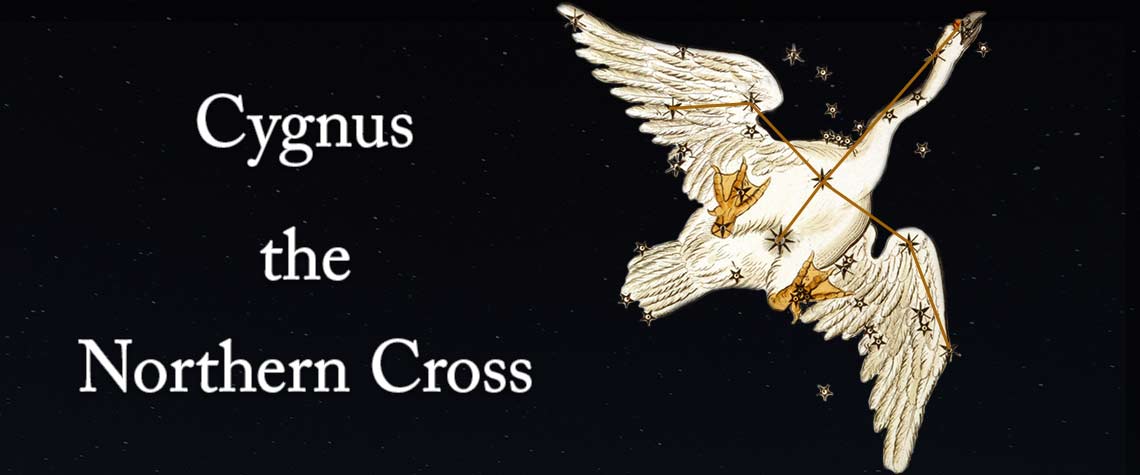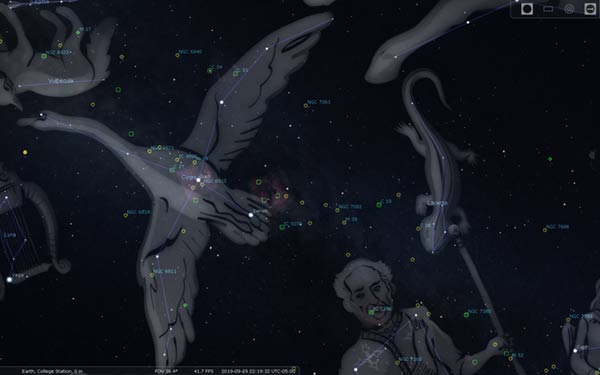Page 3


Eye on the Sky - Cygnus
By Tom Campbell
Cygnus is the constellation of the Swan. Due to the shape of its brightest stars, it is also called the Northern Cross.
There are many varied myths and legends relating to this constellation. One story involves two gods who were racing chariots in space. The two friends were so intent and focused on the race that they were not paying attention to where they were going. Suddenly, they found themselves too close to the sun, and their chariots started to melt.
The two friends fell toward the Earth. One fell through some trees, which broke his fall. The other landed in a river and was knocked unconscious. The first friend wanted to rescue the other from the river but did not know how to swim. He asked Zeus to turn him into a swan, so that he could dive to the bottom of the river and save his friend.
Moved by the young man's friendship, Zeus turned him into a swan. He dove to the bottom of the river and saved his friend's life. Zeus was again moved by his bravery, so when the swan died, Zeus placed him in the sky to serve as a reminder of courage and friendship.
Nestled right along the backbone of the Milky Way, there are many celestial delights in Cygnus. From double stars to clusters to nebulae to supernova remnants, you're sure to see something interesting every time you point your telescope in this region of the sky.
β Cygni, commonly known as Albireo, is a beautiful binary system which forms the beak of the Swan. The pair is wide and colorful, best seen at low magnification where the lemon yellow primary and pale blue companion contrast nicely with other background stars. There is still some debate about whether or not this pair is actually a binary system or merely an optical double. Regardless, they are a gorgeous sight in the eyepiece.
Messier 29 is an open cluster, sometimes called the Cooling Tower or Little Sisters. Some find that it looks like a miniature version of the Big Dipper or the Pleiades. In my 60mm refractor, about 10 stars were visible, looking a bit like the wings of a butterfly.
Messier 39 is a relatively sparse open cluster, with a few dozen stars visible altogether in my 12-inch Dobsonian.
Caldwell 15 (NGC 6826) is called the Blinking Planetary Nebula by amateur astronomers because of its tendency to blink in and out of visibility when going from averted vision to direct vision. In my 8-inch Dob, the stellar core appeared blue-white at 305x and the fuzzy nebulous shell was a bit oval in shape.
Caldwell 20 (NGC 7000) has the common name of the North America Nebula. Unfiltered, this was completely invisible in my 8-inch Dob, but an O-III filter made it quite obvious in rural skies. It is very large and requires a bit of panning around to see it all.
Caldwell 27 (NGC 6888) is also known as the Crescent Nebula or Ear Nebula. This emission nebula responds nicely to an O-III filter, revealing a ghostly C-shaped arc in my 8-inch Dobsonian.
Caldwell 33 (NGC 6992) is better known as the Eastern Veil Nebula. Unfiltered, this large, wispy supernova remnant is only visible in dark skies. However, an O-III filter will bring it out in moderate skies. Believed to be the result of a supernova explosion over 8,000 years ago, the nebula is very large, stretching across about 3° of sky and known collectively as the Cygnus Loop. This is the easternmost half of the loop. Many filaments and tendrils are obvious even at moderate apertures.
Caldwell 34 (NGC 6960) is the Western Veil Nebula and sometimes called the Witch's Broom Nebula or Cirrus Nebula. The western half of the Veil Nebula is enhanced by the fortunate positioning of a bright field star.
NGC 6811 is also known as the Hole in a Cluster or Nefertiti's Headpiece. It contains about 1000 stars, but only a couple dozen are visible in small telescopes. The center of the cluster is nearly devoid of stars, giving the impression of a donut or a cluster with a hole in the center.
NGC 6819 has been called the Foxhead Cluster or the Octopus Cluster. It was discovered on May 12, 1784 by Caroline Herschel. Through my 8-inch reflector, the brightest stars in the cluster were arranged in two arcs, resembling butterfly wings. At one end of one of these arcs was a tight little knots of several bright stars. A couple knots of dimmer stars were also seen.
NGC 6866 is affectionately known as the Kite Cluster. It was discovered by Caroline Herschel on July 23, 1783. Through an 8-inch Dob, I could detect a couple dozen stars, fairly compact. There were a few brighter stars interspersed, which may not have been part of the cluster. The main part of the cluster is oblong and in the center are two almost parallel arcs of bright stars, similar to rounded off chevrons.
NGC 6910 has been nicknamed the Inchworm Cluster or the Rocking Horse Cluster by amateur astronomers. It was discovered by William Herschel on October 17, 1786. About 15 stars were visible in my 8-inch, resembling a wavy Y. Two of the stars were really bright, perhaps foreground stars.
| Object | Type | Mag(s) | Dist. (ly) | R. A. | Dec. |
|---|---|---|---|---|---|
| Albireo (β Cyg) | Double Star | 3.4, 5.1 | 386 | 19h 30.7m | +27° 58' |
| M 29 (NGC 6913) | Open Cluster | 6.6 | 13,048 | 20h 23.9m | +38° 31' |
| M 39 | Open Cluster | 4.6 | 825 | 21h 31.8m | +48° 26' |
| C 15 (NGC 6826) | Planetary Nebula | 8.8 | 5187 | 19h 44.8m | +50° 31' |
| C 20 (NGC 7000) | H-II Region | 4.0 | 1892 | 20h 58.8m | +44° 20' |
| C 27 (NGC 6888) | Emission Nebula | 7.4 | 4700 | 20h 12.1m | +38° 21' |
| C 33 (NGC 6992) | Supernova Remnant | 7.0 | 1470 | 20h 56.3m | +31° 45' |
| C 34 (NGC 6960) | Supernova Remnant | 7.0 | 1470 | 20h 45.6m | +30° 42' |
| NGC 6811 | Open Cluster | 6.8 | 3600 | 19h 37.3m | +46° 23' |
| NGC 6819 | Open Cluster | 7.3 | 7200 | 19h 41.3m | +40° 11' |
| NGC 6866 | Open Cluster | 7.6 | 3900 | 20h 03.9m | +44° 09' |
| NGC 6910 | Open Cluster | 7.4 | 3710 | 20h 23.1m | +40° 46' |
